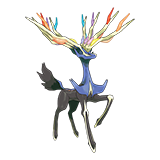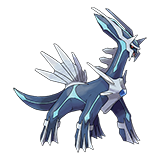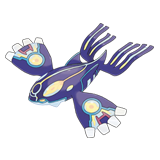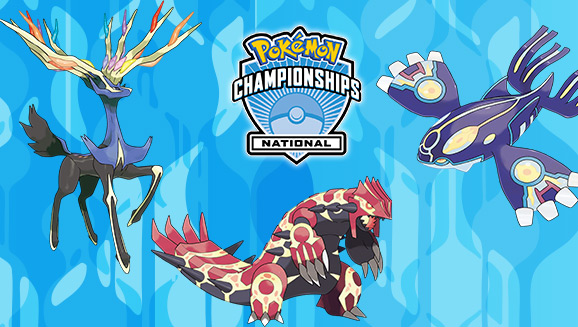Trainers in North America are about to take on their final test before the 2016 World Championships when the US National Championships begin on July 1. Video Game players will be competing for their piece of a prize pool of over $50,000, the largest of any North American tournament in the Pokémon Video Game Championships circuit. Registration is now open, but don’t worry if you can’t make it out yourself—you’ll be able to check out all the action as it happens on Pokemon.com/Live.
Trainers looking to earn the cash prizes, scholarships, and Championship Points available at US Nationals will face their steepest challenge of the season. Masters Division players will have to navigate three days of intense best-of-three battles to come out on top, while Junior and Senior Division players will start their climb on Saturday. Nationals is the last chance for Trainers to earn the Championship Points to qualify for an invitation or Travel Award to the 2016 World Championships, so everyone is sure to bring their best to Columbus.
Figuring Out the Field
One of the challenges players face entering large, important tournaments is anticipating the teams their opponents are likely to bring to battle. Each Trainer must select a single team to use all weekend before battles start on Friday. The winning player will need to play almost twenty best-of-three matches, and they won’t be able to lose more than four of them. Repeatedly running into disadvantageous matchups will spell disaster for even the craftiest Trainers, so bringing the right team is crucial to success.
 The unique restrictions of the 2016 Video Game Championships
have created a stable metagame approaching this US National Championships.
Players are allowed to use two of the extremely powerful group of fifteen
Legendary Pokémon normally prohibited from official competitions on their
teams. These Pokémon are so powerful that Trainers tend to focus their whole
team’s strategies around them. Most players in North America have stuck to the
combinations of Groudon and Xerneas or Groudon and Kyogre, despite Yveltal
recently taking home a National Championship in Germany and teams featuring Rayquaza
dominating in Italy.
The unique restrictions of the 2016 Video Game Championships
have created a stable metagame approaching this US National Championships.
Players are allowed to use two of the extremely powerful group of fifteen
Legendary Pokémon normally prohibited from official competitions on their
teams. These Pokémon are so powerful that Trainers tend to focus their whole
team’s strategies around them. Most players in North America have stuck to the
combinations of Groudon and Xerneas or Groudon and Kyogre, despite Yveltal
recently taking home a National Championship in Germany and teams featuring Rayquaza
dominating in Italy.
Barring a massive shift in the final days before US Nationals, it seems clear that Groudon with Xerneas and Groudon with Kyogre are the main two duos players will focus on as we approach the tournament. But like last year, when Mega Gardevoir unexpectedly won in a field most players expected to be dominated by Mega Kangaskhan, Mega Charizard Y, and Mega Salamence, there’s plenty of opportunity for an overlooked team to become the surprise victor. For now, we’ll take a look at the teams the top Masters Division players in North America have used entering the big dance in Columbus.
Team Geomancy
 The combination of Groudon and Xerneas requires little introduction
for anyone who has followed the 2016 Video Game Championship season. This duo
has been winning tournaments since the format was introduced in January, and
while it has slowed down a little in recent months, it’s certainly still one of
the most powerful teams available. Many of the top players in North America
brought teams with Groudon and Xerneas on them to the Spring Regional
Championships. Excluding players who have already played in National
Championships, six of the ten players with the most Championship Points in
North America used Groudon and Xerneas to make it to the Top Cut of Regionals
in May.
The combination of Groudon and Xerneas requires little introduction
for anyone who has followed the 2016 Video Game Championship season. This duo
has been winning tournaments since the format was introduced in January, and
while it has slowed down a little in recent months, it’s certainly still one of
the most powerful teams available. Many of the top players in North America
brought teams with Groudon and Xerneas on them to the Spring Regional
Championships. Excluding players who have already played in National
Championships, six of the ten players with the most Championship Points in
North America used Groudon and Xerneas to make it to the Top Cut of Regionals
in May.
Xerneas tends to be the star of these teams. Trainers give it the Power Herb item to hold, which causes its Geomancy move to activate in one turn and quickly increase Xerneas’s Sp. Atk, Sp. Def, and Speed by two levels. After a boost from Geomancy, Xerneas can take on most teams nearly on its own, so players tend to dedicate the rest of their team to making Xerneas even more difficult to stop. Groudon is a perfect fit with Xerneas as the second restricted Pokémon on a team. Groudon is extremely powerful, and more importantly it has a natural advantage against the Steel-type, Poison-type, and Fire-type foes that resist Xerneas’s Fairy-type attacks.
 The four other Pokémon selected for teams featuring this duo
normally contribute to one main goal: help Xerneas use its moves safely. Early
in 2016, many players were teaming Groudon and Xerneas up with Kangaskhan, Salamence, Smeargle, and Talonflame.
This version of the team features a great deal of power and several ways to
assist Xerneas at the expense of being weaker on defense than most modern
teams. With Kangaskhan’s Fake Out move, Talonflame’s Tailwind and Quick Guard
moves, Salamence’s Intimidate Ability, and nearly a dozen different support
moves Smeargle is sometimes taught, this team features an extensive suite of
options to support Xerneas. While most Trainers have adjusted their teams to
bulk up on defense, one notable exception is the team Ian McLaughlin used to win the Kansas
Regional Championship. He proved that this team variation can still be
successful while securing himself 9th place in Championship Points after the
tournament. We expect to see many players use a team very similar to Ian’s in
Columbus.
The four other Pokémon selected for teams featuring this duo
normally contribute to one main goal: help Xerneas use its moves safely. Early
in 2016, many players were teaming Groudon and Xerneas up with Kangaskhan, Salamence, Smeargle, and Talonflame.
This version of the team features a great deal of power and several ways to
assist Xerneas at the expense of being weaker on defense than most modern
teams. With Kangaskhan’s Fake Out move, Talonflame’s Tailwind and Quick Guard
moves, Salamence’s Intimidate Ability, and nearly a dozen different support
moves Smeargle is sometimes taught, this team features an extensive suite of
options to support Xerneas. While most Trainers have adjusted their teams to
bulk up on defense, one notable exception is the team Ian McLaughlin used to win the Kansas
Regional Championship. He proved that this team variation can still be
successful while securing himself 9th place in Championship Points after the
tournament. We expect to see many players use a team very similar to Ian’s in
Columbus.
Paul Chua won two Regional Championships using Groudon and Xerneas, making him the top player in North America who hasn’t already competed in a National Championship. Paul also started out with Talonflame on his team, but he was one of the many Trainers who swapped Talonflame out for Cresselia in the spring. He was notably joined in making this change by two other players high in the Championship Points standings: 19th place Conan Thompson and 23rd place Collin Heier. Many of the moves Cresselia is often taught—especially Gravity and Skill Swap—are more effective at helping out Groudon than Xerneas. This helps makes teams like Paul’s a little less one-dimensional, no longer relying solely on Xerneas’s Geomancy. To complete his shift in strategy Paul also moved away from a Groudon that specializes in special attacks to one that prefers physical attacks. The Northeast is widely considered to be one of the strongest regions in North America, so winning both of the VGC 2016 Regionals in the area certainly makes Paul a player to follow in Columbus.
 Two-time National Champion Wolfe Glick is next on the
Championship Points rankings, and he also used Groudon and
Xerneas in the spring after winning with Dialga and Kyogre during the winter.
Wolfe’s team was similar to Paul’s, with Bronzong taking the place of
Cresselia. Bronzong gives Wolfe some added offensive power against Xerneas and
Weavile at the expense of being a little easier to knock out than Cresselia.
Another important difference between Wolfe’s and Paul’s teams is that Wolfe’s
Xerneas has a Bold Nature to improve its Defense, while Paul’s Xerneas has the
more common Timid Nature to boost Speed. We’ve seen a few other tricky Trainers
using a more defensive Xerneas. This swap enables Trainers to power-up their Xerneas
and switch into attacks more safely, at the expense of being slower than other
Xerneas. With two National Championships under his belt already, Wolfe is again
a favorite in 2016.
Two-time National Champion Wolfe Glick is next on the
Championship Points rankings, and he also used Groudon and
Xerneas in the spring after winning with Dialga and Kyogre during the winter.
Wolfe’s team was similar to Paul’s, with Bronzong taking the place of
Cresselia. Bronzong gives Wolfe some added offensive power against Xerneas and
Weavile at the expense of being a little easier to knock out than Cresselia.
Another important difference between Wolfe’s and Paul’s teams is that Wolfe’s
Xerneas has a Bold Nature to improve its Defense, while Paul’s Xerneas has the
more common Timid Nature to boost Speed. We’ve seen a few other tricky Trainers
using a more defensive Xerneas. This swap enables Trainers to power-up their Xerneas
and switch into attacks more safely, at the expense of being slower than other
Xerneas. With two National Championships under his belt already, Wolfe is again
a favorite in 2016.
Ashton Cox has built a reputation for being one of the most unpredictable and exciting battlers in the Video Game Championships. Like Wolfe, he added a Top-4 finish in the spring using Groudon and Xerneas, earning enough Championship Points to net the third spot in Championship Points among players competing only in North America. Never one to rely on standard team compositions, Ashton threw his opponents another curveball in Massachusetts by supporting his Xerneas with Infernape. Infernape is much faster than the Kangaskhan it replaces on this team, allowing it to move first with Fake Out or Quick Guard. Infernape can also use Encore to force an opponent to repeat its previous move, potentially allowing Xerneas to use Geomancy unopposed. The presence of Infernape forces Ashton’s opponents to make difficult decisions, and Ashton has had great success in the past by throwing unfamiliar tactics at his opponents.
 Georgia Regional Champion Toler Webb also swapped
out Kangaskhan for a quicker Pokémon that knew Fake Out. Rather than Kangaskhan
or Infernape, he used the speedy Weavile. While it lacks the resilience of
Kangaskhan and the supportive moves of Infernape, Weavile helps out its team
with lightning speed and excellent types for dealing damage. Toler is also the
reigning US National Champion, and he looks poised for another big tournament
after his recent Regional victory.
Georgia Regional Champion Toler Webb also swapped
out Kangaskhan for a quicker Pokémon that knew Fake Out. Rather than Kangaskhan
or Infernape, he used the speedy Weavile. While it lacks the resilience of
Kangaskhan and the supportive moves of Infernape, Weavile helps out its team
with lightning speed and excellent types for dealing damage. Toler is also the
reigning US National Champion, and he looks poised for another big tournament
after his recent Regional victory.
Riley Factura enters US Nationals 8th in Championship Points thanks to a Utah Regional Championship victory with Amoonguss and Thundurus. These Pokémon make Riley’s team more reminiscent of the teams we’ve seen from players using Groudon with Kyogre to win long battles than other teams built around Xerneas. We saw a similar tactic from 13th place Tommy Cooleen, who used both Thundurus and Cresselia on his Groudon and Xerneas team. If Groudon and Xerneas team up to win the US National Championships, it could very well be at the hands of one of these successful Trainers, so keep an eye on them during the tournament.
Primal Pals
 Teams with both Kyogre and Groudon have made just as large
an impact on the 2016 Video Game Championships as those using the combination
of Groudon and Xerneas in recent weeks. Where teams with Xerneas are focused
around Geomancy, these “Double Primal” teams play more conventionally. Primal
Kyogre and Primal Groudon are extremely powerful on both offense and defense,
and they synergize very well with other flexible, sturdy Pokémon. They form a
perfect core for playing the conservative, grinding strategies we’ve seen come
out on top at many World Championships.
Teams with both Kyogre and Groudon have made just as large
an impact on the 2016 Video Game Championships as those using the combination
of Groudon and Xerneas in recent weeks. Where teams with Xerneas are focused
around Geomancy, these “Double Primal” teams play more conventionally. Primal
Kyogre and Primal Groudon are extremely powerful on both offense and defense,
and they synergize very well with other flexible, sturdy Pokémon. They form a
perfect core for playing the conservative, grinding strategies we’ve seen come
out on top at many World Championships.
The more standard focus of these teams allows Trainers to consider a wider variety of teammates than with Groudon and Xerneas. Thomas Nishimura earned both a first- and second-place Regionals victory by finishing his team with Thundurus, Amoonguss, Weavile, and Salamence. Many Double Primal teams use Thundurus with Cresselia to have two Pokémon with speed control moves, but Tom instead slows down foes with his Kyogre’s Icy Wind attack. While Tom might prefer to knock his opponent’s Groudon out with a Water-type attack instead, Icy Wind can slow opposing Groudon down to enable his own Groudon to move first and score a knockout. Tom is new to the national stage, but he’s proven to be a contender entering Nationals after making the finals of two consecutive Spring Regionals.
 Another top-10 player who made it to the Top Cut of two
Spring Regionals was Chuppa Cross IV. Chuppa’s team features the most common Double Primal
team composition of Salamence, Thundurus, Cresselia, Kangaskhan, Kyogre, and Groudon.
His team isn’t without its twists, however. By teaching his Groudon Swords Dance,
his Kyogre Thunder, and his Salamence Substitute, Chuppa was able to keep his
opponents off-guard and take advantage of turns where his opponent was in a
poor position. This approach was also used by Alejandro
Gomez to win the UK National Championship. We expect to see more than a few
players try teams similar to Chuppa’s and Alejandro’s in Columbus.
Another top-10 player who made it to the Top Cut of two
Spring Regionals was Chuppa Cross IV. Chuppa’s team features the most common Double Primal
team composition of Salamence, Thundurus, Cresselia, Kangaskhan, Kyogre, and Groudon.
His team isn’t without its twists, however. By teaching his Groudon Swords Dance,
his Kyogre Thunder, and his Salamence Substitute, Chuppa was able to keep his
opponents off-guard and take advantage of turns where his opponent was in a
poor position. This approach was also used by Alejandro
Gomez to win the UK National Championship. We expect to see more than a few
players try teams similar to Chuppa’s and Alejandro’s in Columbus.
Several other players in the top-20 of the Championship Points standings also used Double Primal teams at Regionals. Veteran Stephen Morioka tried a tricky variant that included the option of Mega Gengar and its Shadow Tag Ability. James Baek used Bronzong, as some of the Groudon and Xerneas players did. Bronzong was able to make some huge plays with its Hypnosis move on the livestream from Madison. Mitchell Davies and Justin Burns both made the Top Cut using Mawile, Salamence, Bronzong, and Thundurus. This is a similar tactic to what we saw from Diana Bros on our last livestream, and it’s easy to see why. With Xerneas being such an important Pokémon to defeat, stacking Steel-type Pokémon can improve this important matchup.
On the Horizon
 Many players probably expected Double Primal and Groudon
with Xerneas to dominate the European National Championships as well, but the
reality was that we saw a variety of teams finish near the top. We’ve already
started to see some shifts to the standard formula in North America, such as Enosh
Shachar’s team from Massachusetts featuring Groudon and Rayquaza. He
probably won’t be the only top player willing to hold strong against the tides
in Columbus, so keep an eye out for innovation. Some players may have been
holding back their surprises as they built Championship Points with safer teams
to give them the opportunity to take more risks at US Nationals.
Many players probably expected Double Primal and Groudon
with Xerneas to dominate the European National Championships as well, but the
reality was that we saw a variety of teams finish near the top. We’ve already
started to see some shifts to the standard formula in North America, such as Enosh
Shachar’s team from Massachusetts featuring Groudon and Rayquaza. He
probably won’t be the only top player willing to hold strong against the tides
in Columbus, so keep an eye out for innovation. Some players may have been
holding back their surprises as they built Championship Points with safer teams
to give them the opportunity to take more risks at US Nationals.
The National Championships in Europe, South Africa, and Taiwan have recently completed, and the Japanese National Championships are on the horizon. Players at US Nationals often take inspiration from teams that are successful at National tournaments earlier in the season, so we may see some quick changes in Pokémon trends. We’ve already seen unexpected Pokémon such as Mandibuzz, Ditto, Whimsicott, Jumpluff, and even a Lv. 27 Pikachu have success at National tournaments, and it remains to be seen what the savvy Japanese Trainers will bring to battle. Tune in to Pokemon.com/Live from July 1–3 to find out which teams and players come out on top in the United States, and remember to check out Pokemon.com/Strategy for more Pokémon TCG and video game strategy content and tournament coverage.

